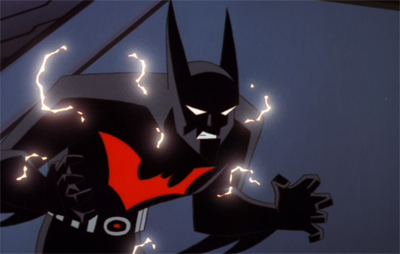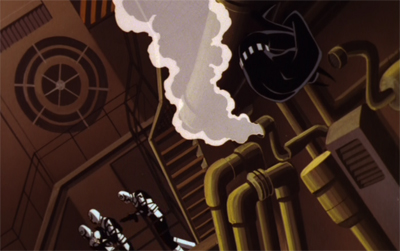This September marks the twentieth anniversary of Batman: The Animated Series, and the birth of the shared DC animated universe that would eventually expand to present one of the most comprehensive and thorough explorations of a comic book mythology in any medium. To celebrate, we’re going back into the past and looking at some classic episodes.
Batman is one of the very few of DC’s major superheroes who faces his own mortality. Superman knows that he inspires the Legion of Superheroes, and his alien physiology could allow him to live forever. Wonder Woman is an immortal. Green Lantern comes from an entire deep space police force. Even Hawkman and Hawkgirl live through a perpetual cycle of reincarnation. Bruce Wayne is just a man, and – as such – he will eventually die. Due to this simple fact, a lot of people have wondered what might happen if Bruce Wayne were confronted with his own mortality.
Batman Beyond explores that potential future.
The show was requested by Warner Brothers, who wanted a show aimed squarely at a teenage demographic featuring Batman. Buffy: The Vampire Slayer was cited. However, rather than simply reworking Batman as a teenage superhero, the production team decided to take the opportunity to explore what might happen when Bruce Wayne was unable to wear the cowl any longer. While various “what-if” stories had suggested that Robin (or even Bruce’s son) might grow up to be Batman, Batman Beyond was one of the first to suggest an entirely new character would wear the suit. (Of course, Terry would later be revealed to be Bruce’s biological son, but he was not created as such.)
Batman typically doesn’t have a very happy future. Frank Miller’s The Dark Knight Returns suggested that Bruce would end up bitter and alone, eventually completely consumed by Batman. Neil Gaiman’s Whatever Happened to the Caped Crusader? suggested that the only outcome for Bruce was death, never surrender. Batman Beyondopens with a revelation about what forced Bruce to retire. Taking on a gang of thugs, Bruce appears to have a heart-attack, a sign that he’s getting on and no longer capable of wearing the cowl. However, that isn’t the reason Bruce quits. Bruce would push himself to the very edge of death, and maybe a little further, in service of his mission.
Even Terry, who barely knows Bruce, knows the man enough to know Bruce didn’t retire because he saw his pending mortality. “Something happened to you, didn’t it?” Terry asks the old man. “And it wasn’t just that you got old.” The opening sequence reveals that Bruce had been forced to wield a gun, something that most iterations of the character would find profoundly upsetting. It’s suggested that this version of the character sees his reliance on the pistol as a sign of moral weakness, and the moment where he just accepts that he can’t do this any more.
I love the idea that Batman’s desperate reliance on a gun would cause the character to question himself so thoroughly that he would give up – it seems like one of the very few things that would possibly deter him. Indeed, it seems like that night “breaks”Bruce. During that adventure, we hear a news clip about how Bruce is perpetually fighting take-over bids from Derek Powers, the billionaire desperate to buy Wayne Enterprises.
When we rejoin Bruce two decades later, Powers has succeeded, and Wayne is desperately out of touch with what Powers is doing with the company. “He’s using my company to make nerve gas,” Bruce growls with contempt. It seems like Bruce has withdrawn so completely from the world that he barely ventures outside. He does venture outside to protect Terry from the Jokerz, but that seems to be the exception rather than the rule. When Terry ties up Ace outside, Bruce frees him using a batarang and meets him at the front door.
Bruce appears to have isolated himself and alienated everybody. He lives alone. Alfred is obviously dead. However, the costumes of Robin, Batgirl and Nightwing are all displayed in the cave, as if to confirm that this version of batman did have an extended family built around him. As such, we’re led to believe that he drove them away, and that he managed to lose even the surrogate family he built up around himself. (Much like Bruce in The Dark Knight Rises succeeds at even pushing Alfred away.)
While Terry’s mother recognises Bruce, it seems the kids have little idea who he is. Terry has to do some reading up on Bruce in order to figure out who he is, and his girlfriend doesn’t seem to recognise Wayne Manor when she drops him off. Much like in Nolan’s The Dark Knight Rises, it seems that killing Batman also killed off Bruce, leaving him a recluse. (Of course, Nolan’s Bruce is eventually able to let go of Batman, in the same way this version eventually does – by finding somebody worthy of taking up the mantle of the Bat.)
It’s very clear from the outset that Terry is not just a younger version of Bruce. When we’re introduced to him, he’s a teenager. His parents are still alive. He’s punky high school kid who seems to come from the working class, but he’s also not the kind of kid who reacts well to bullies. It’s been said before, but there’s really a sense that Terry is an over homage to Peter Parker, more closely resembling that superhero archetype than the brooding and serious Batman.
For one thing, the high school setting brings Lee and Ditko’s Amazing Spider-Man to mind. There’s even a handy bully in the mould of Flash Thompson. Terry doesn’t lose his parents at a young age. He loses his father in his teenage years, and blames himself. “I should have been there!” he tells his mother. “I could have done something!” There’s a sense that Terry is at least better adjusted than Bruce ever was. Although he is confrontational and adversarial, he’s never quite as aggressive or single-minded as Bruce was.
It’s interesting that Terry’s home life seems much more dysfunctional than any insight we’ve had into the life of the Waynes. “Not now, Terry,” his father tells him as he fumbles with some work. “I’m busy.” His parents don’t live in the domestic bliss Bruce recalls. They are divorced. It seems that they never really have time for Terry, and the kid is constantly in trouble at school. It’s a very real family life, one that feels more natural and fluid than Bruce’s idealised memories of his own family. Perhaps the writers were hinting that Bruce’s family life might have been as idyllic as he would like to imagine.
I also like that Batman Beyond literally separates Bruce from Batman. Bruce directs Terry through his headset and the comm unit in his costume, but it means that Bruce and Batman officially exist as two separate entities. It feels like the first stage in the inevitable. batman will have to survive after Bruce passes away, and this process of literally externalising the Batman identity makes that possible. It also serves as a handy illustration of the dichotomy that Bruce has struggled with for decades.
We also get a fairly effective origin scene that plays well off the iconic “I shall become a bat” sequence. Once again, Bruce is in his study while Batman is born. This time, it’s Terry who is drawn by a bat to find his destiny, and is led to take up the mantle. It’s an effective sequence, and the parallels with Batman: Year One raise some interesting questions. In Year One, Bruce was waiting for a sign when the Bat broke through the glass. Was Bruce waiting for another sign when Terry showed up?
If the bat in Year One gave a tired Bruce inspiration, does Terry’s arrival do the same? In Year One, Bruce was looking for a way to rise above the limitations of his flesh and blood to fight injustice. It seems like the Bruce of Batman Beyond might be doing something similar, as he sits in his mansion, idly waiting for death to claim him.
It’s also worth noting that Batman isn’t the only character to leave a legacy. The Joker has carved his own face into the grim urban landscape, with roving kids seeking to imitate the clown prince of crime. The Jokerz are actually a fascinating creation, suggesting that some ideas are self-perpetuating. After all, if there must always be a Batman, must there also be the Joker? If Batman transcends Bruce’s mortality, can the Joker do the same? It’s also fascinating to hear a Joker villain remove a flick knife and comment, “Let’s put a smile on his face.”This was a few years before Heath Ledger would associate that image and line with Joker.
I’ll also admit a massive fondness for the visual design of “Neo Gotham”, the Gotham of the future. It calls to mind any number of pulpy science-fiction, but most obviously Blade Runner in its oriental influence. There’s a genuine sense that this is a dark urban future, and the flipside of the futuristic utopias we see in other films and stories. I have to admit I’m a little disappointed that we never got to see “Neo Metropolis” for comparison, I reckon it would have looked truly beautiful.
Rebirth also establishes Derek Powers as the villain of the piece, setting up a loose arc that would run through the first season of the show, through to the finalé in Ascension. I am quite fond of Powers as a Batman villain, if only because he fills an archetype that I don’t think gets enough play in the world of Batman. He’s an evil corporate executive, in the style of Lex Luthor, and he makes an effective counterpart to Bruce. Sure, villains like the Black Mask have been introduced in comics, but none villain has ever really worked well as a foil to Bruce Wayne, entrepreneur.
The casting of Sherman Howard helps, of course. He gives Powers a sort of a slick exterior, something vaguely sinister without seeming cartoonishly villainous. Well, yet. The final scene of the episode reveals that Powers has evolved into something like futuristic version of Doctor Phosphorus, demonstrating another trick that Timm and his staff would use on Batman Beyond. The writers would typically reinvent lesser-known Batman villains for the new setting, with bad guys like Spellbinder introduced here. (They also did a great job keeping to basic Batman villain archetypes, while avoiding anything as trite as “son of the Riddler” or anything like that.)
Batman Beyond is off to a pretty flying start. It wasn’t the most consistently fantastic show in Timm’s impressive canon, but it was an interesting idea well executed in general. It’s a lovely-looking cartoon, and a fascinating glimpse at what the next evolution of Batman might look like.
Filed under: Television | Tagged: batman, Batman Beyond, Bruce, bruce wayne, Christopher Nolan, ChristopherNolan, dark knight returns, Dark Knight Rises, DarkKnight Rises, dc animated universe, Derek Power, green lantern, Hawkgirl, joker, Jokerz, Terry, Wayne, Wayne Enterprise, Wayne Manor |





























Leave a comment